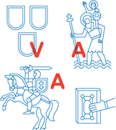Voice of Lithuania in the Cold War: Lithuanian Chapels in the National Shrine, Washington D. C. and Basilica of St Peter in Vatican
| General project amount (Eur) | 65 308,00 |
| Amount in 2020 (Eur) | 34 230,00 |
| Amount in 2021 (Eur) | 24 517,00 |
| Amount in 2022 (Eur) | 6 561,00 |
| Project duration | 2020-03-01 - 2022-12-31 |
| Responsible person | Giedrė Jankevičiūtė |
The aim of the project is to research, interpret and publicize the phenomenon of 2 emblematic examples of Catholic architecture and art – Lithuanian chapels of National Shrine, Washington D. C., and St Peter’s, Vatican – as: 1) a symbolic tool of political struggle of the diaspora for Lithuania’s independence, which was widely seen during the period of Cold War and is gaining new meaning in the current geopolitical conjuncture; 2) a result of the modernization of Lithuanian artistic culture of the mid of the 20 th century, which helped to ensure the visibility of the chapels outside the diaspora.
Worldwide known chapels were set up by the Lithuanian diaspora in the 1960s. The descriptions of chapels are included in texts on Lithuanian Catholic Church history and interpretations of artistic legacy of V. K. Jonynas, the main author of the chapels’ decoration. The historiography identifies the initiators, highlights the symbolic significance of the chapels and discusses their iconographic program. However, the chapels are viewed as 2 separate objects, without attempting to establish their relationship with other forms of diaspora activity, nor addressing their significance to the self-image of the diaspora. The history of the chapels is presented on an empirical level, therefore the links with political engagement and activism of Lithuanians and the participation in the Cold War battles of the diaspora are not clearly identified. The interrelations between the diaspora's identity and the cultural modernization aspirations of the interwar period are undisclosed. Thus, historically significant genetic dependence on the interwar Neo-Catholicism movement, which stimulated the renewal of ecclesiastical art, has not been discussed. The research during the emplementation of activities according to the work plan of the project will help to resolve above mentioned problems and omissions.
Three measures were selected to summarize and disseminate the results of the research, namely a section of the EAM conference with 2 presentations on the project; an exhibition in Vilnius and bilingual (Lithuanian and English) exhibition catalog with academic articles and a well-documented visual section; the catalogue also includes the article of French art historian Dr. Marie-Ange Namy.



